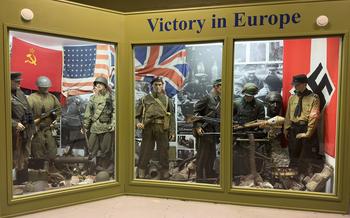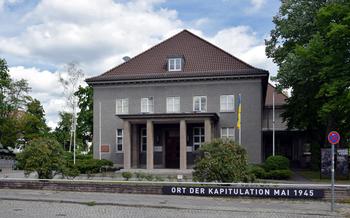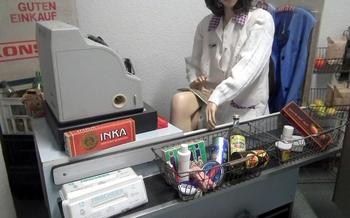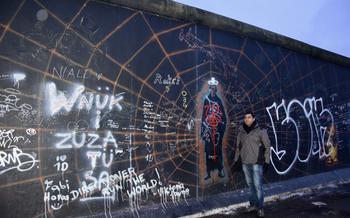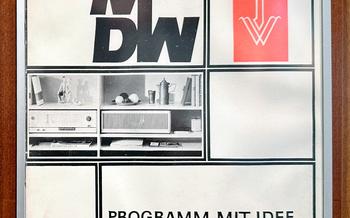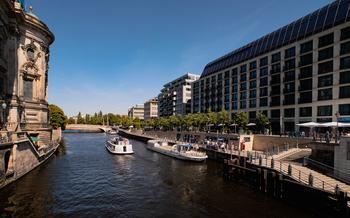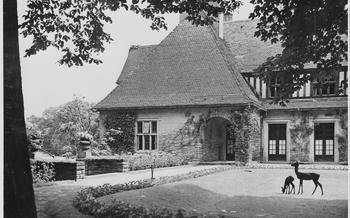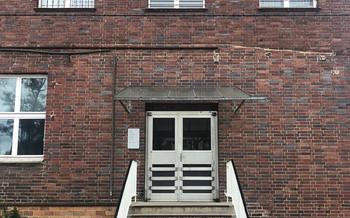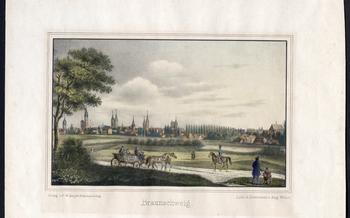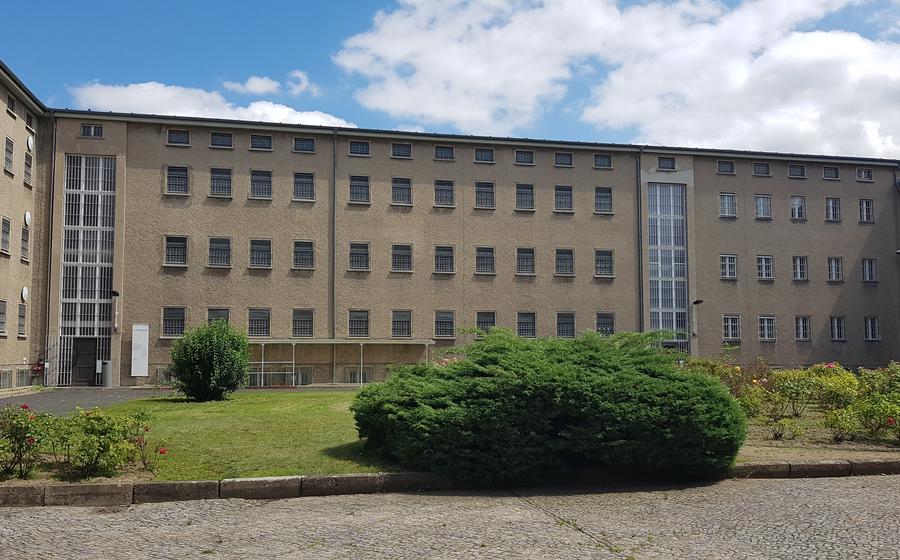
Berlin Hohenschönhausen Memorial
- Preservation and Restoration
- Guided Tours
- Interactive Exhibits
- Former Prison Cells and Guard Towers
- Documentation Center
- Educational Programs
- Memorial Events and Commemorations
- Research and Publications
- International Visitors and Partnerships
- Accessibility and Visitor Information
- Transportation and Parking
- Nearby Attractions and Points of Interest
- Food and Dining Options
- Insider Tip: Enhance Your Visit
Preservation and Restoration
The Berlin Hohenschönhausen Memorial has undergone extensive preservation and restoration efforts to maintain its authenticity and historical integrity while adapting it for public access. The original prison buildings, guard towers, and surrounding grounds have been carefully restored using period-appropriate materials and techniques. The interiors of the prison cells have been preserved to showcase the harsh conditions in which political prisoners were detained. The memorial has also installed modern amenities, such as ramps and elevators, to ensure accessibility for visitors with disabilities. These efforts have resulted in a site that is both respectful of the past and welcoming to the public.
Preserving a site like the Berlin Hohenschönhausen Memorial is crucial for historical education and remembrance. It serves as a physical reminder of the oppressive Stasi regime and the suffering inflicted upon East German citizens. By maintaining the authenticity of the memorial, future generations can gain a deeper understanding of the past and the importance of protecting human rights and freedoms.
Guided Tours
The Berlin Hohenschönhausen Memorial offers a variety of guided tours to enhance visitors' understanding and appreciation of the site's history and significance. General tours provide a comprehensive overview of the memorial, covering its history, the Stasi regime's operations, and the experiences of political prisoners. Specialized tours are available for students and groups with specific interests, such as the role of women in the resistance movement or the Stasi's surveillance methods.
To ensure a personalized and informative experience, booking tours in advance is highly recommended. This is especially important for larger groups, as it allows the memorial staff to tailor the tour to their specific needs and interests. Reservations can be made online or by phone, and visitors are advised to check the memorial's website for availability and pricing information.
Audio guides are also available for visitors who prefer to explore the memorial at their own pace. These guides offer insightful commentary and historical context, allowing visitors to delve deeper into the stories of the former prisoners and the Stasi's oppressive regime.
Interactive Exhibits
The Berlin Hohenschönhausen Memorial offers a range of interactive exhibits and displays that bring the history of the Stasi regime to life. These exhibits use multimedia, personal stories, and historical artifacts to engage visitors and enhance their understanding of the Stasi's oppressive practices.
Through interactive touchscreens, visitors can access a vast archive of documents, photographs, and audio recordings related to the Stasi. These interactive displays provide insights into the surveillance methods employed by the Stasi, the lives of political prisoners, and the resistance movements that emerged in East Germany.
One of the most striking exhibits is a replica of a Stasi interrogation room. Visitors can sit in the same chairs used by political prisoners and experience the psychological pressure and intimidation tactics employed by the Stasi during interrogations.
The memorial also features a multimedia exhibit that tells the personal stories of former political prisoners. Through video interviews and interactive displays, visitors can learn about the experiences of those who were held captive by the Stasi, their struggles for freedom, and their lives after the fall of the Berlin Wall.
These interactive exhibits offer a powerful and immersive way for visitors to understand the human toll of the Stasi regime and the broader context of political oppression in East Germany. They serve as a reminder of the importance of fighting for freedom and human rights, and the resilience of the human spirit in the face of adversity.
Former Prison Cells and Guard Towers
The former prison cells and guard towers at the Berlin Hohenschönhausen Memorial offer a chilling glimpse into the oppressive reality of the Stasi regime. Visitors can walk through the narrow, dimly lit corridors and peer into the cramped cells where political prisoners were held in isolation. The cells are preserved in their original state, with bare concrete walls, metal bunk beds, and a small window that allowed only a sliver of daylight to enter.
The guard towers, which once housed armed Stasi officers, provide a panoramic view of the prison grounds. Visitors can stand in the same spot where guards kept watch over the prisoners, scanning for any signs of dissent or escape attempts. The combination of the physical evidence and the stories shared by former prisoners and guides creates a powerful and emotionally charged experience that brings the horrors of the Stasi regime to life.
Documentation Center
The Documentation Center at the Berlin Hohenschönhausen Memorial serves as a vital repository of historical records and artifacts related to the Stasi and its oppressive activities. This comprehensive collection includes extensive documentation, photographs, and personal accounts that shed light on the inner workings of the Stasi regime and its far-reaching impact on East German society.
The documentation center's primary mission is to preserve and make accessible these historical materials for research and educational purposes. Here, researchers, historians, and the general public can explore a vast archive of documents, including Stasi files, interrogation reports, and surveillance records. These invaluable resources provide a glimpse into the methods and strategies employed by the Stasi to maintain control and suppress dissent.
Furthermore, the documentation center houses a collection of artifacts that offer tangible evidence of the Stasi's oppressive practices. Visitors can examine surveillance equipment, uniforms, and personal belongings confiscated from political prisoners. These artifacts serve as powerful reminders of the human toll exacted by the Stasi regime and the resilience of those who resisted its tyranny.
The documentation center at the Berlin Hohenschönhausen Memorial plays a crucial role in preserving the historical record of the Stasi era and facilitating research on this dark chapter in German history. Through its extensive collection and educational initiatives, the documentation center contributes to a deeper understanding of the Stasi's crimes and the fight for human rights and democracy.
Educational Programs
The Berlin Hohenschönhausen Memorial offers a comprehensive range of educational programs designed to raise awareness about the Stasi regime and its impact on individuals and society. These programs are tailored to various audiences, including students, teachers, and the general public.
Workshops and Seminars:
- The memorial conducts interactive workshops and seminars for students of all ages.
- These programs explore the history of the Stasi, human rights, and the consequences of dictatorship.
- Through discussions, role-playing, and hands-on activities, students gain a deeper understanding of the complexities of the GDR era.
Lectures and Talks:
- The memorial regularly hosts lectures and talks by former political prisoners, historians, and experts on the Stasi regime.
- These events provide a platform for sharing personal experiences, scholarly research, and insights into the functioning of the Stasi.
- Visitors can engage in Q&A sessions and gain a firsthand account of life under the oppressive regime.
Educational Materials:
- The memorial offers a range of educational materials, including lesson plans, worksheets, and multimedia resources for teachers and students.
- These materials support classroom teaching on topics related to the Stasi, the GDR, and human rights.
- Teachers can incorporate these resources into their curriculum to enhance students' understanding of this dark period in history.
The Berlin Hohenschönhausen Memorial's educational programs play a crucial role in fostering critical thinking, promoting human rights education, and ensuring that the lessons of the past are not forgotten.
Memorial Events and Commemorations
The Berlin Hohenschönhausen Memorial organizes and participates in various memorial events and commemorations throughout the year to honor the victims of the Stasi regime and promote remembrance and reconciliation. These events serve as a platform for former political prisoners, human rights activists, government officials, and the general public to come together and pay tribute to those who suffered under the oppressive rule of the Stasi.
One of the most significant annual events is the International Day of Remembrance for the Victims of Stalinism and Nazism, held on August 2On this day, the memorial hosts a special ceremony to commemorate the victims of both totalitarian regimes and to raise awareness about the importance of fighting against all forms of tyranny and human rights violations.
Another important event is the Day of German Unity, celebrated on October This day marks the reunification of East and West Germany in 1990 and provides an opportunity to reflect on the legacy of the Stasi and the challenges faced by the country during the transition to democracy. The memorial organizes public discussions, lectures, and exhibitions to commemorate this historic day.
Additionally, the memorial hosts regular events such as film screenings, book readings, and panel discussions to engage the public with the history of the Stasi and its impact on individuals and society. These events often feature former political prisoners or experts on the GDR who share their personal experiences and insights.
By organizing and participating in these memorial events and commemorations, the Berlin Hohenschönhausen Memorial plays a crucial role in preserving the memory of the victims of the Stasi regime, promoting reconciliation, and raising awareness about the importance of human rights and freedom.
Research and Publications
The Berlin Hohenschönhausen Memorial is not only a place of remembrance and education but also a center for research on the history of the Stasi and the GDR. The memorial's research department conducts in-depth studies on various aspects of the Stasi era, including the surveillance methods, the persecution of dissidents, and the impact of the regime on society. The results of this research are published in academic journals, books, and other publications.
The memorial's extensive collection of documents, photographs, and artifacts serves as a valuable resource for researchers from around the world. The documentation center provides access to these materials, enabling scholars to conduct their own research and contribute to a deeper understanding of the Stasi regime. The memorial also hosts conferences, workshops, and seminars, bringing together experts from various fields to discuss and exchange knowledge on the history of the GDR and the Stasi.
The memorial's research and publications play a crucial role in preserving the historical record and ensuring that the crimes of the Stasi regime are not forgotten. They contribute to a broader understanding of the GDR's oppressive system and its impact on individuals and society. The memorial's commitment to research and scholarship ensures that the lessons of the past are not lost and that future generations can learn from the mistakes of the past.
International Visitors and Partnerships
The Berlin Hohenschönhausen Memorial has gained international recognition for its historical significance and its role in promoting remembrance and reconciliation. It has established partnerships with other memorial sites, research institutions, and human rights organizations worldwide.
These partnerships facilitate the exchange of knowledge, research findings, and best practices related to memorialization, human rights education, and historical research. The memorial actively participates in international conferences, workshops, and events to share its experiences and contribute to broader discussions on the legacy of totalitarian regimes and the promotion of human rights.
Through these partnerships, the memorial contributes to international dialogue and cooperation on issues related to human rights and historical memory. It collaborates with organizations such as the International Committee for Museums and Collections of Modern Art (CIMAM), the International Coalition of Historic Site Museums of Conscience (ICMHSC), and the European Network of Remembrance and Solidarity (ENRS).
The memorial's international partnerships help raise awareness of the Stasi regime and its impact beyond Germany, promoting a shared understanding of the importance of human rights and the prevention of future atrocities.
Accessibility and Visitor Information
The Berlin Hohenschönhausen Memorial is committed to providing an accessible and welcoming environment for all visitors. The memorial is open to the public from Tuesday to Sunday, with guided tours available in German and English. Admission fees are charged, with reduced rates for students, seniors, and groups.
For visitors with disabilities, the memorial offers wheelchair accessibility, ramps, and elevators. Assistance for visitors with special needs can be arranged upon request. Visitor information is available in multiple languages, including English, French, Russian, and Spanish. The memorial also provides a range of educational materials and resources in various formats to accommodate diverse learning styles and needs.
The memorial's staff is dedicated to creating an inclusive and supportive environment for all visitors, ensuring that everyone has the opportunity to learn about the history of the Stasi prison and its significance for human rights and democracy.
Transportation and Parking
Reaching the Berlin Hohenschönhausen Memorial is a breeze, thanks to Berlin's efficient public transportation system. Hop on the M4 tram line and alight at the Genslerstraße stop, which is just a short walk from the memorial's entrance. Alternatively, take the S75 S-Bahn train to Springpfuhl station and follow the signs for a 10-minute stroll to the memorial.
For those who prefer the convenience of driving, the memorial offers ample parking spaces. Simply enter Genslerstraße 66 into your GPS, and you'll find yourself right in front of the memorial. There are designated parking areas for visitors with disabilities, ensuring accessibility for all.
If you're feeling adventurous or eco-conscious, consider exploring Berlin's bike lanes and renting a bicycle. The memorial is easily accessible by bike, and there are bike racks available on-site for your convenience. Ride-sharing services like Uber and Bolt are also widely available in Berlin, offering a hassle-free transportation option.
Nearby Attractions and Points of Interest
The Berlin Hohenschönhausen Memorial is situated in a vibrant and culturally rich neighborhood, offering visitors the chance to explore a variety of other historical sites, museums, and attractions in the vicinity. Just a short walk away, visitors can delve into the history of the GDR at the Stasi Museum, which provides a comprehensive overview of the secret police's activities and methods. For those interested in art and culture, the renowned Gemäldegalerie Alte Meister (Old Masters Picture Gallery) is a must-visit, showcasing a stunning collection of paintings by European masters from the 13th to the 18th centuries.
Beyond these historical and cultural attractions, the area surrounding the memorial offers a wealth of opportunities for exploration. The nearby Volkspark Friedrichshain, one of Berlin's largest and most beautiful parks, invites visitors to relax and unwind amidst tranquil gardens, sprawling meadows, and a picturesque lake. For those seeking a unique shopping experience, the Boxhagener Platz flea market, held every Sunday, offers a vibrant mix of vintage treasures, handmade crafts, and delicious street food.
By combining a visit to the Berlin Hohenschönhausen Memorial with these nearby attractions, visitors can gain a deeper understanding of Berlin's rich history and culture, while also enjoying the vibrant atmosphere of this dynamic neighborhood.
Food and Dining Options
After exploring the sobering history of the Berlin Hohenschönhausen Memorial, visitors can find solace and refreshment in the nearby dining scene. Within walking distance of the memorial, you'll discover a diverse range of culinary options to suit every taste and budget.
For a quick bite or a casual meal, consider the cozy cafes and bakeries that line the streets. Indulge in freshly baked pastries, aromatic coffee, or hearty sandwiches to recharge your energy levels. If you're craving a more substantial meal, venture into the nearby restaurants, where you can savor traditional German cuisine or explore international flavors from around the world.
For a truly immersive experience, try the local dishes that have become synonymous with Berlin. Sample the iconic Currywurst, a grilled sausage smothered in a tangy curry sauce, or treat yourself to a hearty Schnitzel, a breaded and fried cutlet served with potatoes and a creamy sauce.
Whether you're looking for a quick snack or a leisurely dining experience, the area surrounding the Berlin Hohenschönhausen Memorial offers a plethora of culinary delights to satisfy your taste buds and complete your visit.
Insider Tip: Enhance Your Visit
To make the most of your visit to the Berlin Hohenschönhausen Memorial, consider booking a guided tour in advance. These tours are led by experienced guides who can provide in-depth knowledge and insights into the history and significance of the site. They will share personal stories of former political prisoners and shed light on the inner workings of the Stasi regime. Booking a tour is especially recommended for those interested in learning more about the GDR's oppressive system and its impact on individuals and society.
Another insider tip is to visit the memorial during the evening hours. As darkness falls, the atmosphere becomes more somber and reflective, creating a unique opportunity to contemplate the suffering and resilience of those who were imprisoned here. The floodlights illuminating the memorial's exterior cast an eerie glow, adding to the emotional impact of the site. Visiting during the evening hours can provide a deeper and more immersive experience, allowing visitors to connect more profoundly with the memorial's history and legacy.
